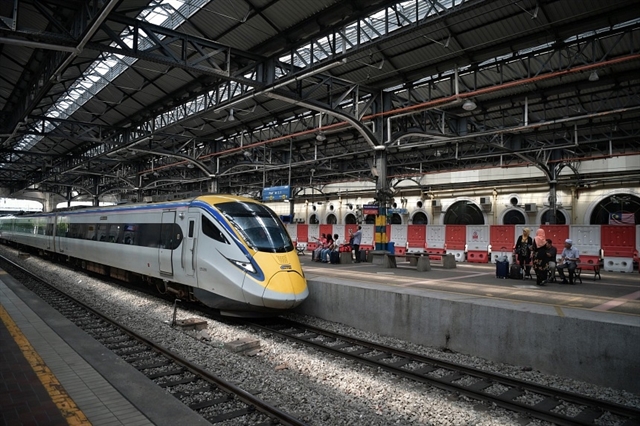 World
World


|
| The electric train service or ETS is part of the ambitious EDTP line that was announced back in 2011. PHOTO ST FILE |
KUALA LUMPUR – The Gemas-Johor Bahru electrified double-track rail project (Gemas-JB EDTP), which is expected to halve the journey time between Kuala Lumpur and Johor Bahru once it links up with the already up-and-running Padang Besar-Gemas line, has missed yet another deadline.
Initial plans to progressively extend the existing line – that begins at the Malaysia-Thailand border in Padang Besar and travels southwards through Gemas – have met headwinds in Johor’s district of Segamat.
Segamat is slated to be the first of a new 11-stop stretch covering major districts in the southernmost state – including Kluang and Kulai – and terminating in Johor Bahru.
The electric train service (ETS) on the 26km stretch from Gemas to Segamat was supposed to commence in October, having already been delayed in July, but missed the deadline for the second time.
Once launched, the stretch would be the first part of the Gemas-JB EDTP, estimated to cost RM9.5 billion (S$2.8 billion).
The most recent delay is due to issues with the electricity supply for running the trains, The Straits Times has learnt.
One official source directly involved in the project said the team is working on the final phase of testing the electrification of the train, and as a result missed the October deadline.
“These tests are essential and must pass to ensure safety during train operations,” added the source, on condition of anonymity, as he is not cleared to speak to the media. The source said train service in the Gemas-Segamat stretch is now expected to start after mid-November.
YTL Construction and joint venture partner SIPP Rail are building the Gemas-JB link.
Another government source told ST that the current delay is due to YTL Construction’s inability to complete the technical aspects of the electric feeder line at Segamat’s Genuang Railway Station, which has prevented the overhead line from being energised.
“This has prevented the train service from venturing further south in the state of Johor,” noted the source.
A feeder line typically carries high-voltage electricity from the main power supply to feeder stations. At these stations, the voltage is stepped down before it is delivered to the railway’s overhead system, which directly supplies the electric trains.
While the laying of tracks on the Gemas-JB stretch is 95 per cent complete, according to the source, other works that are still ongoing involve the testing of the electrification of the trains.
The 192km extension project has also missed several deadlines.
When it first began in 2017, completion was expected by October 2021. However, it has faced significant delays for more than three years due to the Covid-19 pandemic and complications in the land acquisition process, with squatters refusing to vacate the required land.
A new deadline has been set for April 2025. YTL Corporation and the Ministry of Transport (MOT) did not respond to ST queries about the delays.
The ETS is part of the ambitious EDTP line that was announced back in 2011, to upgrade the KTM single-rail line on peninsular Malaysia’s west coast by laying new, double-rail tracks powered by electricity.
It is operated by Malaysian railway company Keretapi Tanah Melayu Berhad (KTM).
The EDTP line was launched during the prime ministership of Najib Razak.
While it has not received as much publicity as the East Coast Rail Link joining Kuala Lumpur to Kelantan and the KL-Singapore High Speed Rail, the EDTP, which, when fully rolled out, will replace diesel trains with electric ones, is viewed by government officials as an important project.
Johor Menteri Besar Onn Hafiz Ghazi said in March 2023 that the MOT and the state government had reached an agreement that the Gemas-JB EDTP is one of two projects that should continue to be given priority. The other is the JB-Singapore Rapid Transit System (RTS) Link.
The Gemas-JB EDTP portion is the final stretch of the electrified train route that will, among other things, improve freight capacity by rail between Malaysia’s Port Klang and Port of Tanjung Pelapas, allow for easier travel between JB and other urban centres in central Johor, and lead to potential urban development in some areas, researchers at ISEAS – Yusof Ishak Institute said in a July 2020 paper.
Paired with the RTS Link, the Gemas-JB rail project could be an alternative to the controversial KL-Singapore High Speed Rail, as both the lines aim to link the Republic and KL, say experts.
The faster ETS service would also enhance connectivity by complementing the RTS Link that is slated to open by January 2027.
It can cut travelling time from Johor Bahru to Kuala Lumpur to 4½ hours, from around seven hours currently by diesel train, KTM told ST.
By car, one would have to drive roughly four hours without any stops to cover the same distance between Johor Bahru and Kuala Lumpur.
Once the electric rail project is completed in 2025, KTM told ST, it is expected to serve around 3,000 passengers a day from JB to KL.
In the first 10 months of 2024, 63,607 people used the current diesel train service on the Gemas-JB route. THE STRAITIMES/ANN